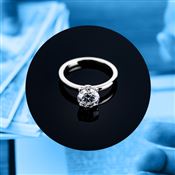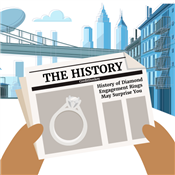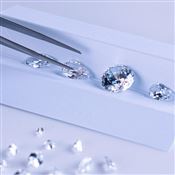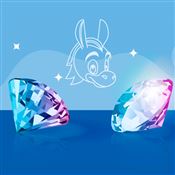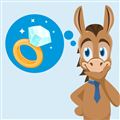Diamond Prices: What You Need to Know
Get the maximum bling for your buck. Know what aspects of a diamond you need to focus on and which ones you don't to get the best value on your engagement ring.
Don't Overpay. Learn About Diamond Pricing Before You Shop
 |
Thinking about buying a diamond? You have probably got a set budget for the engagement ring. And your goal is to get the best, biggest, and shiniest diamond on that budget.
We're going to show you exactly how to do that.
Bottom Line: Save money on color and clarity. You just need an eye-clean (flaws are not visible) diamond. We recommend H color and VS2 clarity diamonds for the sweet spot.
You can find the best deals by comparing prices at the most popular online jewelers:
Search for Beyond Conflict-Free Diamonds
Shop for diamonds at Brilliant Earth, a CreditDonkey recommended partner for socially-responsible diamonds.
Just How Much is a Diamond?
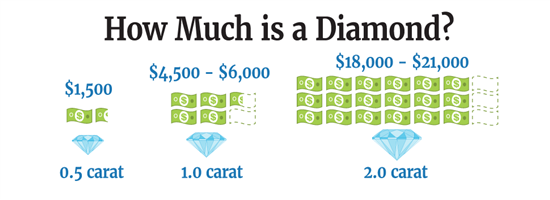 |
| © CreditDonkey |
Before we get into the deep dive, here are the current diamond prices you can expect. Below is a diamond price chart showing the current selling price of diamonds and our recommended budget for best value.
| Carat Weight | Diamond Price Per Carat | Total Price | Recommended Price |
|---|---|---|---|
| 0.25 carat | $800 - $4,000 | $200 - $1,000 | $300 - $450 |
| 0.50 carat | $1,000 - $8,000 | $500 - $4,000 | $1,000 - $1,500 |
| 0.75 carat | $1,300 - $9,000 | $1,000 - $6,800 | $2,000 - $3,000 |
| 1.0 carat | $2,000 - $16,000 | $2,000 - $20,000 | $4,500 - $6,000 |
| 1.5 carat | $2,670 - $20,000 | $4,000 - $30,000 | $8,500 - $12,000 |
| 2.0 carat | $4,000 - $35,000 | $8,000 - $70,000 | $18,000 - $21,000 |
| 3.0 carat | $7,000 - $66,700 | $20,000 - $200,000 | $40,000 - $50,000 |
As you can see, the price range vary quite a bit, even for diamonds of the same carat size. Our recommended price indicates where you get the best balance of price, quality, and beauty in a diamond.
Also, the above prices are for a round diamond. Other diamond shapes cost as much as 20%-40% less than round diamonds.
Pro Tip: Want to get the best value for your diamond? Consider Clean Origin's lab-created diamonds. They're identically composed to mined diamonds but are less damaging to the environment and your wallet.
There is no one-size-fits-all diamond calculator. We'll go over all the factors that determine the final retail price of a diamond. You'll also get our expert tips on how to get the best value and avoid getting ripped off.
This guide takes just 15 minutes to read. By the end of it, you'll be armed with the knowledge to save up to 40% on your engagement ring.
And if you're in a hurry, you can jump straight to the end for our helpful cheat sheet on the top 10 tricks to save on diamond prices that you might not know about.
In this guide, you'll find:
What to Know About Diamond Prices
In this article, we will discuss the industry secrets to diamond prices that jewelers don't want you to know. But before we explain, here are a few things you absolutely need to know to get the best diamond for your money.
- Quality (4C's): The carat weight, cut, color, and clarity determines how much a diamond is worth. The more flawless and colorless the rock, the higher the prices.
But here's a secret: Save yourself money on color and clarity. These characteristics can't usually be seen by the average person. All you need is a diamond that looks eye-clean and white. We recommend H color and VS2 or SI1 clarity as the sweet spot.
- Certification: It's extremely important that you only buy a diamond certified by a reputable lab. The certification is how you know that you paid for the quality advertised.
We recommend diamonds certified by GIA and AGS, as these labs have the highest grading standards.
- Where to Buy: Jeweler markup has the biggest effect on diamond pricing. The same quality stone can be priced many times higher when it comes in a trademark little blue box.
To avoid paying high markup prices, we recommend shopping online. Online retailers can cost as much as 40% less than big name jewelry stores.
Search for Diamonds
Shop for diamonds at Whiteflash, a CreditDonkey recommended partner for super ideal cut diamonds.
How Much is a 1 Carat Diamond?
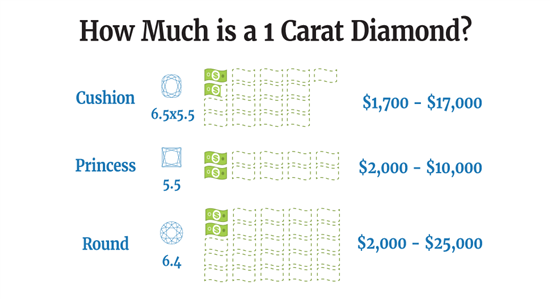 |
| © CreditDonkey |
The average diamond size for engagement rings is around 1 carat. So, just how much can you expect to pay for a 1-carat diamond? Here is a general pricing guide:
- $2,000 to $25,000 for round
- $2,000 to $10,000 for princess
- $1,700 to $17,000 for cushion
Here's a chart to show prices of 1.0 carat diamonds with different grades.
| Diamond | Price | Color | Clarity |
|---|---|---|---|
| 1 Ct Round | $9,000 | E | VVSI |
| 1 Ct Round | $7,500 | F | VVS2 |
| 1 Ct Round | $6,500 | G | VS1 |
| 1 Ct Round | $5,500 | H | VS2 |
| 1 Ct Round | $4,000 | I | SI1 |
A good price for a 1 carat engagement ring is around $4,500 - $6,000 for an ideal cut diamond of H color and VS2 clarity. We will explain what cut, color and clarity means in this article.
This chart below shows the diamond price ranges of a 1-carat, round ideal-cut stone. Based on the color and clarity grades, you can easily see the vast pricing difference.
| IF | VVS1 | VVS2 | VS1 | VS2 | SI1 | SI2 | |
|---|---|---|---|---|---|---|---|
| D | $13-$16k | $10-$13k | $8k-$11k | $7-$10k | $6.5-$9k | $5.5-$8k | $4.5-$7k |
| E | $11k | $9-$11.5k | $7.5-$10k | $6.5-$9k | $6-$8k | $5-$7k | $4.3-$6k |
| F | $10-$11k | $9-$10k | $7.5-$9k | $6-$9k | $6-$8k | $5-6.5k | $4-$5.5k |
| G | $8-$9.5k | $6.5-$9k | $6.5-$8k | $6-$8k | $5.5-$7.5k | $5-$6k | $4-$5k |
| H | $6.3-$7.3k | $6-$8k | $5.5-$7k | $5.5-$7k | $5.3-$6.5k | $4.7-$6k | $4-$5k |
| I | $5.7-$6.3k | $5.2-$6.3k | $5-$6k | $5-$6k | $4.7-$6k | $4-$5.5k | $3.5-$4.3k |
| J | $5k | $4.5-$5.5k | $4-$5k | $4-$5.3k | $4-$5.3k | $3.7-$4.7k | $3.3-$4.3k |
The highlighted boxes show our recommendations for best value. Color H and clarity of VS2 will get you a white-looking diamond that appears eye-clean. If you can find an eye-clean diamond at the SI1 clarity level, even better.
How Much is a 2 Carat Diamond?
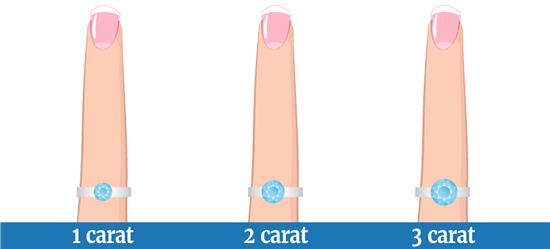 |
| © CreditDonkey |
A 2-carat diamond can cost as low as $7,000 and as high as over $60,000. The price depends on factors like diamond shape, color, clarity, and cut. A good value, good quality 2 carat diamond should cost you around $16,000 - $21,000.
Here is a price chart based on an ideal cut, round 2-carat diamond:
| IF | VVS1 | VVS2 | VS1 | VS2 | SI1 | SI2 | |
|---|---|---|---|---|---|---|---|
| D | $65-$73k | $45-$60k | $35-$55k | $30-$50k | $25-$40k | $20-$30k | $15-$25k |
| E | $45-50k | $35-$50k | $30-$45k | $23-$43k | $20-$35k | $17-$30k | $14-$23k |
| F | $35-$45k | $30-$40k | $26-$40k | $22-$35k | $20-$32k | $17-25k | $13-$22k |
| G | $30-$40k | $25-$35k | $25-$32k | $22-$32k | $18-$28k | $15-$25k | $12-$20k |
| H | $23-$30k | $20-$30k | $20-$30k | $18-$28k | $17-$25k | $15-$23k | $13-$21k |
| I | $18-$22k | $17-$24k | $16-$22k | $15-$22k | $15-$20k | $13-$20k | $11-$18k |
| J | $15-20k | $13-$18k | $13-$18k | $13-$17k | $12-$16k | $10-$16k | $10-$14k |
The highlighted boxes are where we recommend you stay to get the best value - a diamond that appears white and eye-clean. Also, keep in mind that for fancy shapes, you can knock an extra 10% to 40% from these prices too.
How Much is a 3 Carat Diamond?
A 3-carat diamond can cost anywhere from $20k to $200k+. For the best value, we recommend a 3-carat diamond with color H and clarity VS2, which will cost around $35,000 - $50,000, depending on the shape.
To learn more and to avoid common costly mistakes, read our detailed guide on shopping for a 3-carat diamond.
How Diamond Prices are Calculated
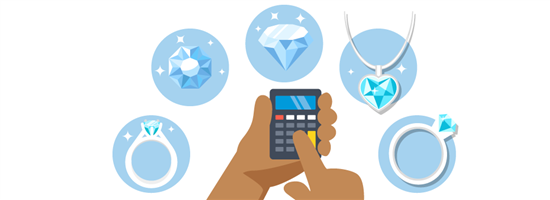 |
Diamond prices are calculated per carat. The per-carat price increases exponentially as you move up in carat weight. This is because it is more rare to find bigger sized diamonds.
For example, a .25 carat round diamond starts at around $300 and a .5 carat round diamond starts at around $780. But a 1 carat round diamond jumps up all the way to $3,000+. For best value, we recommend staying just under half or whole carat weights (for example, go for 0.9 carat instead of 1 carat).
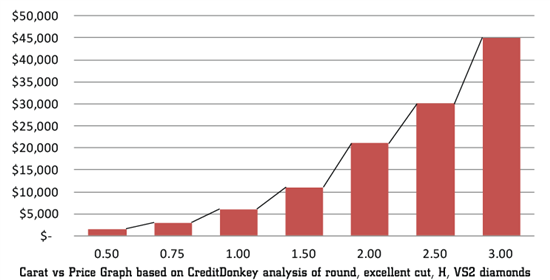 |
| Diamond Price vs Carat © CreditDonkey |
Did you know: Like diamonds, no two snowflakes are alike?
How to Calculate Price per Carat
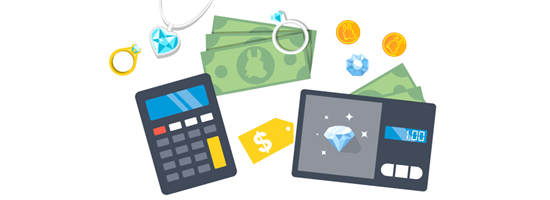 |
Carat Weight x Price per Carat = Total Diamond Cost
Here's how it works:
- If a 0.9 carat diamond is $5,500 per carat, the total diamond price would be $4,950 (0.9 x $5,500)
- If a 2 carat diamond is $9,700 per carat, the total diamond price would be $19,400 (2 x $9,700)
Let's say you're deciding between two diamonds with the same color, clarity, and cut. Both look the same in size.
- A 0.88 carat diamond that costs $5,000. The per carat price is $5,682 ($5,000/0.88)
- A 0.82 carat diamond that costs $4,800. The per carat price is $5,853 ($4,800/0.82)
Even though the 2nd diamond costs less, it's actually more per carat. So in this case, maybe you would think the first stone is the better value.
Note that to compare the per-carat price, you must be comparing apples to apples. You need to compare diamonds with the same cut, color, clarity, fluorescence, and lab certificate. You also need to look at actual appearance. This means whether flaws, tints, or haziness are visible.
- How much is a 0.5 carat diamond? A good quality 0.5 carat diamond (H, VS2) is around $3,000 per carat. This means the diamond itself would be priced at $1,500 (0.5 * $3,000).
- How much is a quarter of a carat diamond worth? A similar quality 0.25 carat diamond is around $2,000 per carat. So the diamond itself would cost $500 ($2,000 * 0.25).
Wholesale Diamond Prices
The Rapaport is a price list that's intended to be a benchmark for global diamond pricing. It's released every Friday and shows the current value of individual loose diamonds.
However, it's not meant to be the ultimate diamond market price chart. The Rapaport merely serves as a baseline for sellers to establish their own pricing. It's also used to keep up with changes in diamond pricing.
Here is an example of what a Rapaport looks like:
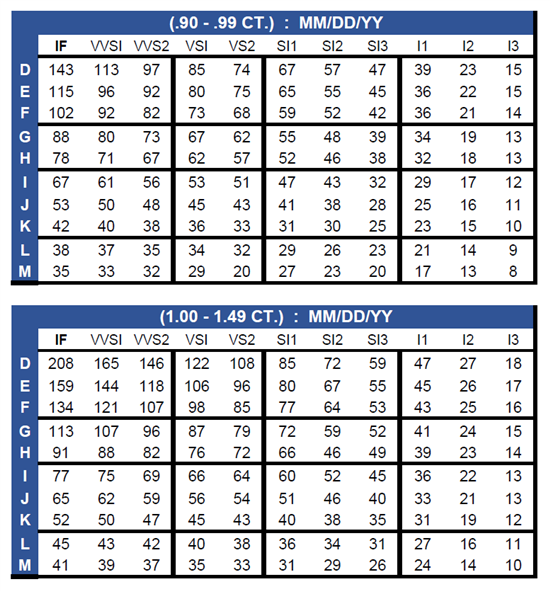 |
| Sample Diamond Price Chart |
| Note: this chart is for illustrative purposes only and does not reflect actual diamond prices. |
The Rapaport is shown as a grid comparing color and clarity of different carat ranges. The numbers are by the hundreds (43 = $4,300). The price listed is per-carat. You have to multiply your carat weight by the listed number to arrive at the final diamond price.
There are other similar reports:
- RapNet: This is part of Rapaport's Diamond Trading network. The prices listed here are the actual average asking price by sellers. This is only accessible to jewelers and dealers.
- IDEX (International Diamond Exchange): The diamond prices listed on the IDEX report are higher than Rapaport's. Diamond retailers would usually apply a discount when selling.
What's Wrong with Industry Diamond Price Charts?
If there's a whole chart about diamond prices, then why don't we just use that?
The Rapaport chart makes diamond pricing seem so simple. But there are some problems with it, including:
- It doesn't take cut into account. Rapaport prices are only based on carat, color, and clarity. But cut is a very important factor. It affects how brilliant the diamond appears. And the pricing difference between different cut grades can be huge.
- Different diamonds of the same grade can look very different. One SI2 diamond can be completely eye-clean while another one has visible flaws. One D colored diamond can be beautiful and clear while another looks hazy because of strong fluorescence. Of course the diamond that looks more beautiful will be sold at a higher price.
- The price is high. Rapaport itself says the price listed is the "high asking price." Retailers will generally apply a discount. Some jewelers will show you the Rapaport pricing and tell you that you're getting a "good deal" because they're selling for less. If you're unfamiliar with diamond prices, you may be fooled into believing that.
Instead, use this article to learn how to get the biggest diamond with most sparkle for the best value. Learn about key factors that affect diamond prices. Then you'll learn how to shop for diamonds online to save even more money and get the maximum value.
Online stores like James Allen lets you view your exact diamond in a 360 degree, 15x magnification, high-definition picture.
Do Diamond Prices Increase Over Time?
Maybe you're wondering if a diamond is a good investment, and if the value will appreciate.
Historical data shows that diamond prices have increased on average 4% per year, over the past 10 years. This seems to be mostly keeping in line with inflation.
In the early 2000's, an average-quality (H, VS2) 1-carat diamond was priced at $5,900 on Rapaport. In 2010, such a diamond was listed at $6,300, while it is $7,600 today.
However, just because a diamond's retail price increases over time, it doesn't mean that the diamond will have good resale value. Unfortunately, the resale market is weak.
As soon as you have purchased the diamond, the value has already gone down. And you will never be able to sell a diamond even close to what you paid. You shouldn't count on a diamond as an investment.
How to Get Lower Diamond Prices
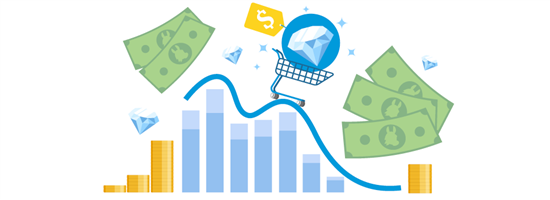 |
The 4Cs
You've probably heard people talk about the 4Cs of diamonds: carat, cut, color, and clarity. This is a good place to start your diamond education.
The 4Cs combine to determine the overall beauty and price of a diamond. But that doesn't mean each C carries equal weight.
Don't waste your money. Some Cs are just not as important as the others, yet can cause a huge spike in price. If you don't understand the basics, you could be spending a ton of money on features you can't even appreciate.
Some of the most common mistakes include:
- Purchasing a diamond too high in color and clarity thinking it will make the diamond "shinier."
- Assuming that all diamonds are cut the same and therefore a better color and clarity is what's needed.
- Placing too high of a priority on carat size and then having to sacrifice in other areas to stay within budget, resulting in a dull, poor quality diamond.
Search for Beyond Conflict-Free Diamonds
Shop for diamonds at Brilliant Earth, a CreditDonkey recommended partner for socially-responsible diamonds.
Don't make these mistakes. This guide will help you know what to prioritize and what you can "cheap out" on.
Carat - Is This the Most Important C?
Most people prioritize carat. That's why it's first on this list. However, in our opinion, it's not necessarily the most important.
Carat is overall the most visible of the 4Cs. Most admirers say "Wow what a big rock!" instead of "Wow what a colorless and flawless rock!"
Unfortunately, it's probably the one area you have the least control over. You probably already have a goal or "requirement" and can't stray too far from it.
So, what is carat exactly? Carat refers to the weight of the diamond. One carat is equal to about 0.2 grams, which is roughly the weight of a paperclip. The heavier the carat weight, the larger the diamond.
Carat has the largest impact on diamond prices. Let's look at how that happens. These are all round diamonds with the same quality. The only difference is the carat weight.
| Carat | Color | Clarity | Cut | Price* |
|---|---|---|---|---|
| 0.3 | H | VS2 | Ideal | $450 |
| 0.5 | H | VS2 | Ideal | $1,200 |
| 0.75 | H | VS2 | Ideal | $2,800 |
| 1.0 | H | VS2 | Ideal | $5,500 |
| 1.5 | H | VS2 | Ideal | $11,000 |
| 2.0 | H | VS2 | Ideal | $19,500 |
| 3.0 | H | VS2 | Ideal | $45,000 |
| *Pricing based on typical market price of online diamond retailers as of 2023. | ||||
The diamond price increases exponentially as the carat goes up. A 0.5 carat diamond is almost twice the price of a 0.3 carat. It again doubles when you go up to .75 and then again at 1 carat. This is because it gets more rare to find raw materials good enough to make larger diamonds.
Pro tip: The largest price jumps are at those desirable half-carat and whole-carat points. To get a better value, look for a diamond just slightly under the whole number.
For example, a 1-carat H, VS2 diamond costs $5,100. But a 0.9 carat diamond of the same specs costs $4,100 - a full thousand dollars less. Would anyone be able to tell the difference? it's highly unlikely.
Don't spend the money on something you can't even see. You would need a size difference of 20% apart to be able to tell.
Why You Should Pay Attention to Cut
We're saying this now and we'll probably say it a lot more before the end of this article. Diamond cut is the MOST important factor, and you should NEVER skimp on it.
In fact, put whatever money you can save on other areas into the cut.
Cut is what makes the diamond shiny and sparkly. And it can literally make the diamond so sparkly that it hides flaws and masks slight color.
Cut refers to proportion, symmetry, and polish - NOT shape. A rough diamond has no shine. A diamond only sparkles because of how it's cut and how light bounces off each angle and facet. A poorly cut diamond will leak light and therefore appear dull. While a well-cut diamond will reflect light and look super brilliant.
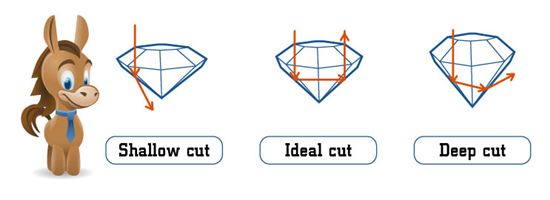 |
| Diamond Cut Scale © CreditDonkey |
In fact, a bad cut can make the diamond look smaller.
If a diamond is cut too deep, this means more of the weight will be in the bottom. This is wasted because you don't even see the bottom part on a ring. The face-up part, where you do see, will be smaller.
You don't want to overpay for a diamond that looks smaller than it should be.
A well-cut diamond will be right size. And plus, a sparkly diamond will just look bigger because of the brilliance.
So how does the pricing differ for cut? Here's a table showing diamond prices at different cuts (all other aspects the same):
| Carat | Color | Clarity | Cut | Price* |
|---|---|---|---|---|
| 1.0 | H | VS2 | Good | $4,300 |
| 1.0 | H | VS2 | Very Good | $4,600 |
| 1.0 | H | VS2 | Ideal / Excellent | $5,500 |
| 1.0 | H | VS2 | Super Ideal | $8,000 |
| *Pricing based on typical market price of online diamond retailers as of 2023. | ||||
An Ideal / Excellent cut is enough to get you a beautiful, sparkly ring. You don't need to splurge for Super Ideal unless you want the absolute crème de la crème. But to be honest - the average person won't see a difference.
The diamond price jumps quite a bit to the excellent cut, but this when that extra money is well worth it as the difference in quality is very visible.
Not only do you get a diamond that sparkles, you can also afford to down a bit in the other Cs - and save money there!
Color - Does It Matter?
A lot of people think that color and clarity affect how brilliant the diamond is. In fact, they have nothing to do with it.
However, color does still make an impact on the overall beauty of the ring.
Color refers to a slight yellow tint in colorless diamonds. The color ranges from D (completely colorless) to Z (obvious yellow/brown tint), though diamond retailers typically don't sell anything less than K for engagement rings.
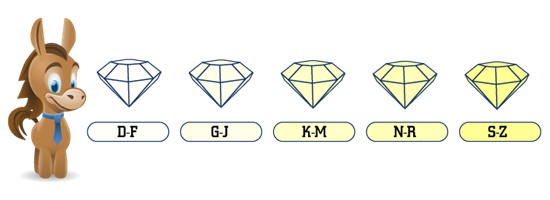 |
| Diamond Color Scale © CreditDonkey |
True colorless diamonds are extremely rare and therefore, priced at a premium. Most diamonds have a slight yellow tint, but most of the time, it's undetectable to the naked eye.
The difference in price as you go up and down color grades is truly staggering. Here's an idea of how wildly it swings. All these diamonds are 1 carat with a clarity of VS2 and an excellent cut. The only difference is the color.
| Carat | Color | Clarity | Cut | Price* |
|---|---|---|---|---|
| 1.0 | K | VS2 | Ideal | $3,200 |
| 1.0 | J | VS2 | Ideal | $3,700 |
| 1.0 | I | VS2 | Ideal | $4,600 |
| 1.0 | H | VS2 | Ideal | $5,300 |
| 1.0 | G | VS2 | Ideal | $5,600 |
| 1.0 | F | VS2 | Ideal | $6,200 |
| 1.0 | E | VS2 | Ideal | $6,400 |
| 1.0 | D | VS2 | Ideal | $6,700 |
| *Pricing based on typical market price of online diamond retailers as of 2023. | ||||
But here's the thing: Most people cannot tell the difference between colorless and nearly-colorless diamonds. And there's really no point in splurging on something with no visible difference.
To get the best value for your money, we recommend going with H. It's in the near-colorless category, so the price is cheaper, but most people can't see a yellow tint at all.
Fold a pure white business card in half and place the diamond in the crease. Look at it away from the spotlights. If you see any yellow at all, it will also appear yellow when set in white gold or platinum. This diamond is most likely at best a J or K.
The color of the setting can make a huge impact. H is a good choice for a platinum or white gold engagement ring. For yellow gold or rose gold bands, you can go down to a J or even K color diamond and it'll still appear white against the band.
What if H is still out of your budget? Easy - go down in color even more. Personally, we'd rather have a J-colored diamond with an excellent cut than an H diamond with just a fair cut.
Find Your Perfect Ring with Vintage & Classic Designs
- Discover popular styles for your dream engagement ring.
- Experience easy shopping with in-person or virtual appointments.
- Enjoy value, variety, and luxury in your diamond hunt.
Clarity - Not As Important As You Think
Clarity refers to the flaws on a diamond. There are two types of flaws: inclusions (internal flaws) and blemishes (flaws on the surface).
It actually doesn't matter if your diamond contains flaws (most do). All you have to do is get a diamond with flaws you cannot see (called "eye-clean"). You don't need a high clarity diamond for it to be eye-clean.
Clarity is last of the 4Cs on our list because you cannot see most flaws with the naked eye. Clarity grade is assigned based on what flaws can be seen under 10x magnification.
In real life, nobody is going to examine your engagement ring that closely. A flaw would have to be pretty major to be visible to the casual observer.
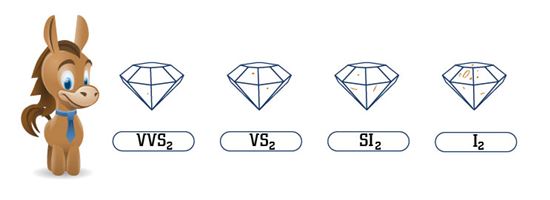 |
| Diamond Clarity Scale © CreditDonkey |
We recommend VS2 as the most bang for your buck. The VS clarity grading refers to diamonds that have more noticeable flaws under magnification but most likely can't be seen with the naked eye.
VS2 diamonds are generally eye-clean. If VS2 is out of your budget, it's possible to find eye-clean diamonds in the SI1 and SI2 range, and even I1 if your budget is truly limited.
Let's take a look at the price differences as we move up and down in clarity (with all other aspects being the same).
| Carat | Color | Clarity | Cut | Price* |
|---|---|---|---|---|
| 1.0 | H | I1 | Ideal | $3,000 |
| 1.0 | H | SI2 | Ideal | $3,500 |
| 1.0 | H | SI1 | Ideal | $4,500 |
| 1.0 | H | VS2 | Ideal | $5,300 |
| 1.0 | H | VS1 | Ideal | $6,000 |
| 1.0 | H | VVS2 | Ideal | $6,500 |
| 1.0 | H | VVS1 | Ideal | $7,200 |
| 1.0 | H | IF | Ideal | $7,800 |
| *Pricing based on typical market price of online diamond retailers as of 2023. | ||||
As you can see, the difference in diamond prices as clarity increases is astounding.
Internally flawless diamonds are priced so high because of how rare they are. But just like with color, you won't be able to appreciate this because the difference isn't visible. You shouldn't pay $2,000 more just to have "flawless" written on a piece of paper.
Shape of the Diamond Makes a Difference Too
You might already know what shape your girl prefers or maybe you have no clue.
If it's the latter, you may have some flexibility budget-wise here. An alternative shape also makes for more unique engagement rings.
Round diamonds are the most expensive and most traditional. Their popularity is due to the fact that round diamonds exhibit incredible brilliance. But if you think your girl could appreciate a unique shape, consider other diamond shapes as they are all cheaper than round.
- Princess cut diamonds are the second most popular shape because they are almost as sparkly as round diamonds. Princess cut diamonds are edgy and contemporary, yet still feminine and delicate.
- Oval diamonds put a modern, elegant twist on the classic round. It is for the girl who appreciates tradition but likes to express individuality. Oval diamonds are in the family of brilliant cuts, so they are close to round in terms of brilliance.
- Other fancy cuts, such as pear and marquise, scream for attention. A woman drawn to these likes to stand out in a crowd. These shapes are also great because they often look larger than a round diamond of the same carat weight.
- Step cuts, such as asscher and emerald, were very popular during the art deco period. These are for the sophisticated lady with vintage tastes.
- Other square/rectangular cuts, such as radiant or cushion, will appeal to those who like the princess cut but want something a little less mainstream.
Pricewise, here's how they compare, using 1 carat, H color, and VS2 clarity as the benchmark.
| Shape | Carat | Color | Clarity | Price* |
|---|---|---|---|---|
| Round | 1.0 | H | VS2 | $5,300 |
| Princess | 1.0 | H | VS2 | $4,200 |
| Cushion | 1.0 | H | VS2 | $3,400 |
| Oval | 1.0 | H | VS2 | $4,500 |
| Pear | 1.0 | H | VS2 | $5,000 |
| Marquise | 1.0 | H | VS2 | $5,800 |
| Emerald | 1.0 | H | VS2 | $3,600 |
| Asscher | 1.0 | H | VS2 | $3,600 |
| Radiant | 1.0 | H | VS2 | $3,700 |
| Heart | 1.0 | H | VS2 | $4,300 |
| *Pricing based on typical market price of online diamond retailers as of 2023. | ||||
You can save as much as 20%-40% by going with a shape other than round. You can then put that money towards a larger/better stone or a fancier setting.
Certification: The Fifth C
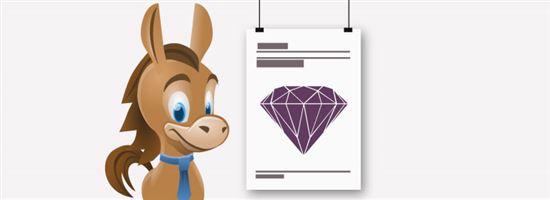 |
| © CreditDonkey |
Certification is super important, so much so that it's often thought of as the 5th C.
There are several diamond grading labs around the world: GIA, AGS, EGL, and IGI to name a few. These labs all have their own grading criteria and standards.
We recommend that you buy diamonds certified by GIA or AGS. These two labs are the most respected worldwide and have the highest, most consistent grading standards.
For example, another lab may grade a diamond as VS2 clarity that would really be graded as an SI2 by GIA. Other labs may inflate their quality by as much as two whole grades. You'd be paying for an inferior product that just looks good on paper.
Diamonds certified by GIA and AGS are pricier (as much as 10% - 30%), because it is more expensive to receive a certification from them. But this is an area that you absolutely should not compromise on.
Diamond Fluorescence Can Work In Your Favor
There is one last characteristic you need to know about - diamond fluorescence.
Fluorescence is when a diamond shows a soft glow under ultraviolet light (usually blue). This is caused by certain minerals in the diamond. This effect is totally natural, appearing in one third of all diamonds.
Usually, fluorescence doesn't cause any negative effects on the appearance of a diamond. But since it's generally seen as a "bad" thing, the good news for you is that a diamond with fluorescence can be priced 2%-15% lower.
In diamonds with lower color grades (I and lower), the blue can counteract the slight yellow tint and improve the face-up color usually by one whole color grade. So you can buy a cheaper diamond with fluorescence in a lower color grade, and have it appear whiter.
For an in-depth guide at diamond fluorescence, please read this article.
Natural vs. Lab Diamonds
We want to quickly mention lab created diamonds (or synthetic diamonds). This makes a huge difference in pricing.
So far, the pricing are all for naturally mined diamonds. But lab diamonds are becoming very popular for engagement rings. Not only are they cheaper, they're also eco-friendly.
Lab created diamonds are the same as natural diamonds with the same carbon structures. The process is just sped up in a controlled lab. Even gemologists can't tell the difference.
Because they can be made in mass quantities in a lab, synthetic diamonds are much cheaper. They are now as much as 80% less than a similar natural diamond.
Here's some pricing to give you an idea (diamonds are all G color and VS1 clarity):
| Natural Diamond* | Lab Diamond* | |
|---|---|---|
| 1.0 carat round diamond | $6,200 | $1,600 |
| 1.0 carat princess diamond | $4,800 | $1,800 |
| 1.5 carat round diamond | $15,000 | $2,600 |
| 1.5 carat oval diamond | $13,500 | $2,800 |
| 2.0 carat round diamond | $28,000 | $4,700 |
| *Pricing based on typical market price of online diamond retailers as of 2023. | ||
No, they are very different. Treated diamonds are natural diamonds that have been enhanced. Typically, these will be poor quality diamonds treated to increase the color and/or clarity. A brown diamond can become white after a color enhancement. There are also clarity treatments to remove and fill flaws.
You can buy a treated diamond for up to 50% less. It sounds good, right? But be careful, because treatments can weaken the diamond and make it easier to damage. A treated diamond should be properly disclosed on the report.
Other Factors that Affect Diamond Pricing
Besides diamond characteristics factors, there are a couple of other things that affect how retailers price their diamonds:
- Jeweler markups: This has the biggest effect on diamond prices. Of course, prestigious brand names such as Tiffany and Harry Winston have high premiums. But popular mall jewelry stores have high markups as well. Stores with a physical location need to pay for a lot of overhead (the store itself, staff, etc., not to mention commission to salespeople), so these costs are passed onto customers. Online diamond retailers have less overhead, so they can sell their diamonds at a lower price.
- Jeweler policies: Some jewelers will give you a lifetime warranty, free resizing, and 100% buy-back. These generous policies can be factored into the selling price of the diamond.
What the Experts Say
This gift is a symbol of eternal love to the most important person in your life. But buying the right one can be overwhelming.
As part of our series on engagement rings, CreditDonkey asked a panel of industry experts to answer readers' most pressing questions. Here's what they said:
Bottom Line
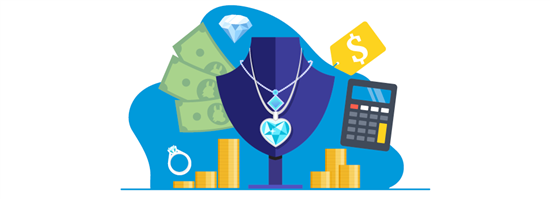 |
Here's a quick cheat sheet for diamond buying:
- Go just below the 1 carat mark (or half carats) for a big drop in price - as much as 20%.
- Color and clarity do not affect the brilliance of the stone, so you don't need to splurge on flawless and colorless rocks. Cut is what determines how sparkly it is, so don't cheap out on this. Put whatever money you have into this area.
- A clarity of VS2 offers the most value for the money because most people won't be able to see the small inclusions.
- A color of H is the best value for diamonds set in white gold or platinum bands.
- Getting a yellow or rose gold setting will save you more, because you can safely go down to a J or K diamond.
- Round diamonds are the shiniest but also the priciest. Consider a fancy shape for a more unique, yet budget friendly engagement ring.
- Look for a diamond lower in color grade with medium-strong fluorescence for a significant price drop and a whiter appearance at the same time.
- Multiple smaller diamonds cost a lot less than one single larger diamond. The halo setting is great for making a smaller center diamond appear huge on a budget.
- Only buy a diamond graded by GIA and AGS to ensure you receive the quality advertised.
- Online diamond stores offer prices as much as 50% less than big name jewelry retailers.
Do you feel ready to shop for an engagement ring now? Picking a diamond is part emotion and part science. It's about hitting that balance of all 4Cs so that you get a stone that satisfies all your preferences while staying within your budget.
Search for Beyond Conflict-Free Diamonds
Shop for diamonds at Brilliant Earth, a CreditDonkey recommended partner for socially-responsible diamonds.
We hope this diamond price guide has given you a good starting point to understand diamonds and what to expect in cost. Please read our how to buy an engagement ring guide for more information.
Good luck!
References
- ^ Federal Trade Commission. Summary of Basis and Purpose for the Revised Jewelry Guides, Retrieved 12/21/2022
Write to Anna G at feedback@creditdonkey.com. Follow us on Twitter and Facebook for our latest posts.
Note: This website is made possible through financial relationships with some of the products and services mentioned on this site. We may receive compensation if you shop through links in our content. You do not have to use our links, but you help support CreditDonkey if you do.
|
|
| ||||||
|
|
|









